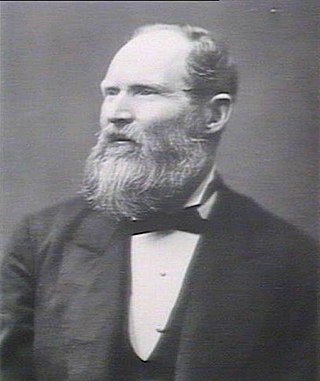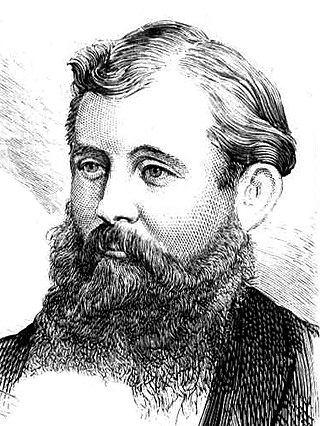Related Research Articles

Sir George Richard Dibbs KCMG was an Australian politician who was Premier of New South Wales on three occasions.

James Squire Farnell was an Australian politician and Premier of New South Wales. Farnell was a hard-working legislator who gave much study to the land question and also tried hard for some years to pass a bill for the regulation of contagious diseases.
Lane Cove, an electoral district of the Legislative Assembly in the Australian state of New South Wales, has had two incarnations, the first from 1904 to 1913, the second from 1927 to the present.
Ryde, an electoral district of the Legislative Assembly in the Australian state of New South Wales, has had four incarnations since it was first established in 1894. It has returned one member for most of its existence, except for the period 1920 to 1927 when it returned five members.
Parramatta, an electoral district of the Legislative Assembly in the Australian state of New South Wales, has continuously existed since the establishment of the Legislative Assembly in 1855.

John Fitzgerald Burns was an Australian politician, member of the Parliament of New South Wales, Postmaster-General in the 1870s and Colonial Treasurer in the 1880s.
Newtown, an electoral district of the Legislative Assembly in the Australian state of New South Wales, has had four incarnations, the first from 1859 to 1894, the second from 1904 until 1920, the third from 1927 until 1950 and the fourth from 2015 until the present.
Gloucester an electoral district of the Legislative Assembly in the Australian state of New South Wales had two incarnations from 1880 until 1920 and from 1927 until 1988.
The 1907 New South Wales state election involved 90 electoral districts returning one member each. The election was conducted on the basis of a simple majority or first-past-the-post voting system.
The 1904 New South Wales state election involved 90 electoral districts returning one member each. The election was conducted on the basis of a simple majority or first-past-the-post voting system. There were two significant changes from the 1901 election, the first was that women were given the right to vote, which saw an increase in the number of enrolled voters from 345,500 in 1901, to 689,490 in 1904. The second was that as a result of the 1903 New South Wales referendum, the number of members of the Legislative Assembly was reduced from 125 to 90. The combined effect of the changes meant that the average number of enrolled voters per electorate went from 2,764, to 7,661, an increase of 277%. Leichhardt was the only district that was not substantially changed, while The Macquarie and The Murray districts retained nothing but the name.
The 1885 New South Wales colonial election was for 122 members representing 72 electoral districts. The election was conducted on the basis of a simple majority or first-past-the-post voting system. In this election there were 35 multi-member districts returning 85 members and 37 single member districts giving a total of 122 members. In the multi-member districts each elector could vote for as many candidates as there were vacancies. 7 districts were uncontested. There was no recognisable party structure at this election. The average number of enrolled voters per seat was 1,831, ranging from East Maitland (1,018) to Canterbury (2,630).
The 1882 New South Wales colonial election was for 113 members representing 72 electoral districts. The election was conducted on the basis of a simple majority or first-past-the-post voting system. In this election there were 32 multi-member districts returning 73 members and 40 single member districts. In the multi-member districts each elector could vote for as many candidates as there were vacancies. 13 districts were uncontested. There was no recognisable party structure at this election. The average number of enrolled voters per seat was 1,701, ranging from East Maitland (984) to Wentworth (2,977).
The 1860 New South Wales colonial election was for 72 members representing 60 electoral districts. The election was conducted on the basis of a simple majority or first-past-the-post voting system. In this election there were 8 multi-member districts returning 20 members and 52 single member districts. In the multi-member districts each elector could vote for as many candidates as there were vacancies. 15 districts were uncontested.
St George, an electoral district of the Legislative Assembly in the Australian state of New South Wales was created in 1894 and abolished in 1904.
Namoi, an electoral district of the Legislative Assembly in the Australian state of New South Wales had two incarnations, from 1880 to 1894 and from 1904 to 1950.
A by-election was held for the New South Wales Legislative Assembly electorate of Newtown on 13 January 1883. The election was triggered by the appointment of Henry Copeland as Secretary for Public Works in the Stuart ministry.
Botany, an electoral district of the Legislative Assembly in the Australian state of New South Wales was created in 1894 and abolished in 1950.
Central Cumberland, an electoral district of the Legislative Assembly in the Australian state of New South Wales was created in 1859 and abolished in 1894.
Goldfields West, an electoral district of the Legislative Assembly in the Australian state of New South Wales was created in 1859 and abolished in 1880.
New England, an electoral district of the Legislative Assembly in the Australian state of New South Wales, was created in 1859 and abolished in 1894.
References
- ↑ Green, Antony. "Elections for the District of St Leonards". New South Wales Election Results 1856-2007. Parliament of New South Wales . Retrieved 22 October 2020.
- ↑ "Part 5B alphabetical list of all electorates and Members since 1856" (PDF). NSW Parliamentary Record. Parliament of New South Wales . Retrieved 22 October 2020.
- ↑ "Former Members". Members of Parliament. Parliament of New South Wales . Retrieved 11 December 2019.
- ↑ Green, Antony. "1917 St Leonards". New South Wales Election Results 1856-2007. Parliament of New South Wales . Retrieved 3 May 2020.
- ↑ Green, Antony. "1913 St Leonards". New South Wales Election Results 1856-2007. Parliament of New South Wales . Retrieved 3 May 2020.
- 1 2 Green, Antony. "1910 St Leonards". New South Wales Election Results 1856-2007. Parliament of New South Wales . Retrieved 26 October 2019.
- 1 2 Green, Antony. "1907 St Leonards". New South Wales Election Results 1856-2007. Parliament of New South Wales . Retrieved 4 December 2019.
- ↑ Green, Antony. "1901 St Leonards". New South Wales Election Results 1856-2007. Parliament of New South Wales . Retrieved 4 December 2019.
- ↑ "St. Leonards". The Sydney Morning Herald . 25 July 1904. p. 10. Retrieved 4 December 2019– via National Library of Australia.
- ↑ Green, Antony. "1904 St Leonards". New South Wales Election Results 1856-2007. Parliament of New South Wales . Retrieved 4 December 2019.
- ↑ "Notes and comments". The Sydney Morning Herald . 25 July 1907. p. 11. Retrieved 4 December 2019– via National Library of Australia.
- ↑ Green, Antony. "1904 St Leonards". New South Wales Election Results 1856-2007. Parliament of New South Wales . Retrieved 9 March 2020.
- ↑ "State elections: the Liberal campaign". The Daily Telegraph . 28 July 1904. p. 9. Retrieved 9 March 2020– via Trove.
- ↑ Green, Antony. "1901 St Leonards". New South Wales Election Results 1856-2007. Parliament of New South Wales . Retrieved 29 March 2020.
- ↑ Green, Antony. "1898 St Leonards". New South Wales Election Results 1856-2007. Parliament of New South Wales . Retrieved 7 April 2020.
- ↑ Green, Antony. "1895 St Leonards". New South Wales Election Results 1856-2007. Parliament of New South Wales . Retrieved 9 April 2020.
- ↑ Green, Antony. "1894 St Leonards". New South Wales Election Results 1856-2007. Parliament of New South Wales . Retrieved 11 April 2020.
- 1 2 Green, Antony. "1891 St Leonards". New South Wales Election Results 1856-2007. Parliament of New South Wales . Retrieved 12 April 2020.
- ↑ Green, Antony. "1889 St Leonards". New South Wales Election Results 1856-2007. Parliament of New South Wales . Retrieved 18 April 2020.
- 1 2 Green, Antony. "1887 St Leonards by-election". New South Wales Election Results 1856-2007. Parliament of New South Wales . Retrieved 8 May 2021.
- ↑ Green, Antony. "1887 St Leonards". New South Wales Election Results 1856-2007. Parliament of New South Wales . Retrieved 20 April 2020.
- ↑ Green, Antony. "1885 St Leonards". New South Wales Election Results 1856-2007. Parliament of New South Wales . Retrieved 21 April 2020.
- ↑ Green, Antony. "1882 St Leonards". New South Wales Election Results 1856-2007. Parliament of New South Wales . Retrieved 22 April 2020.
- ↑ Green, Antony. "1880 St Leonards". New South Wales Election Results 1856-2007. Parliament of New South Wales . Retrieved 24 April 2020.
- ↑ Green, Antony. "1877 St Leonards". New South Wales Election Results 1856-2007. Parliament of New South Wales . Retrieved 25 April 2020.
- ↑ Green, Antony. "1874-5 St Leonards". New South Wales Election Results 1856-2007. Parliament of New South Wales . Retrieved 26 April 2020.
- ↑ Green, Antony. "1872 St Leonards". New South Wales Election Results 1856-2007. Parliament of New South Wales . Retrieved 28 April 2020.
- ↑ Green, Antony. "1869-70 St Leonards". New South Wales Election Results 1856-2007. Parliament of New South Wales . Retrieved 28 April 2020.
- ↑ Green, Antony. "1864-5 St Leonards". New South Wales Election Results 1856-2007. Parliament of New South Wales . Retrieved 29 April 2020.
- ↑ Green, Antony. "1860 St Leonards". New South Wales Election Results 1856-2007. Parliament of New South Wales . Retrieved 29 April 2020.
- 1 2 Green, Antony. "1860 St Leonards by-election". New South Wales Election Results 1856-2007. Parliament of New South Wales . Retrieved 22 June 2021.
- ↑ Green, Antony. "1859 St Leonards". New South Wales Election Results 1856-2007. Parliament of New South Wales . Retrieved 1 May 2020.